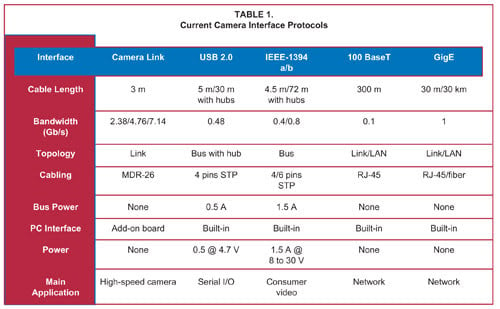Emerging technology standards will provide enough bandwidth to handle the most demanding storage and imaging postprocessing needs.
Joseph Sgro, FastVision LLC
In recent years, the high-performance camera market has enjoyed an explosion in new technology. With both CCD and CMOS sensors offering acceptable image quality and increasingly high frame rates, users have had a myriad of solutions to meet their imaging needs. However, with the upside comes the down. The faster frame rates pose new problems, including the fact that they can surpass most current computer processing and external interconnect standards. Productive use of these high-speed sensors presents a challenge to engineers.
Another alternative is available, however, for meeting today’s performance requirements: A data stream of 1 to 2 GB/s can be sent to a storage device rather than processed in real time. Technologies such as Camera Link, USB 2.0, FireWire and Gigabit Ethernet can handle these rates, but they are complex and expensive. The specifications and intended applications of today’s camera interface protocols show the wide range of options available (Table 1).

Tomorrow’s emerging technologies include InfiniBand, Serial RapidIO, 10Gig Ethernet, Serial Advanced Technology Attachment (SATA), Serial Attached SCSI (SAS) and PCI-Express. These methods use the same proven physical layer currently running in the 2.5- to 3.2-GHz range and often use the same cables and connectors (Table 2).

SATA and SAS are possible candidates for camera interconnects, especially if video data archiving is required. The former is a serial link, which means that a single cable with a minimum of four wires creates a point-to-point connection between devices. Transfer rates for this link begin at 150 MB/s and rise to 300 MB/s in the second generation. One of its main design advantages is that the thinner serial cables not only facilitate more efficient airflow inside a form factor, but also allow smaller chassis designs. The biggest advantage derives from Intel’s intent to make it a standard part of the PC architecture by including SATA and SATA-RAID (redundant array of inexpensive disks) support in a majority of its system controller chips.
SAS is the logical synthesis of SCSI — including its long-established software advantage and the SATA electrical and physical connection interface. The main argument for SAS will be volume and maturity of existing SCSI-centric software used by enterprise- and network-attached storage farms.
SATA, SAS and SCSI protocols (such as Fibre Channel) are specifically optimized for massive data transfers to and from large data depositories. Their main advantages are predictability and reliability of data delivery in known and well-defined and -managed configurations, not unlike digital cameras.
On the other end of the interconnect configuration spectrum are GigE and 10GigE protocols that target the Internet Protocol networks. Ethernet is the preferred choice for the sporadic delivery of unstructured data from anywhere to anywhere. The main advantage of GigE and 10GigE is widespread and ubiquitous connectivity.
InfiniBand and RapidIO have emerged from the needs of cluster computing that is very sensitive to latency of data exchanges and synchronization among large numbers of processors. InfiniBand was motivated by a need for a loosely coupled “computer room interconnect.” It targets blade servers with the emphasis on reliable data transfer among thousand of computer systems. Appli?cations include high-speed image scanning, processing, data storage and retrieval.
From the beginning, RapidIO has targeted high-speed real-time embedded systems with the emphasis on the latency of data distribution and exchange among cooperating computing systems as well as with overall bandwidth. The tightly coupled cooperative processing involving a large number of processors is vital in filling the demanding requirements of image processing and fusion found among intelligence, surveillance and reconnaissance defense applications. Sur?prisingly, similar requirements are found in wafer and reticle (mask) image inspection in semiconductor manufacturing.
The newest arrival to the high-speed serial interconnect family, PCI-Express is driven by Intel to fulfill a much more focused goal of establishing the standard universal high-speed input/output data interconnect in the PC architecture. It provides seamless support for PCI legacy devices and seamless scalability for input/output devices and, most of all, achieves very high bandwidth input/output data transfers in PC systems.
As a high-speed serial interconnect, PCI-Express is naturally compatible with both copper and fiber links. Its wide acceptance could lead to disappearance of PC boxes, replaced with nearly invisible constellations of small CPU and devices connected wirelessly and by thin copper and fiber cables. The technology will provide tight and transparent integration of video cameras and other video devices with computers.
Furthermore, PCI-Express and 10GigE are especially attractive because they are beginning to be widely adopted by major suppliers and vendors. In the near future, these interconnections are expected to achieve commodity status and to expand into the 3- to 10-GHz range. Also, there is the economy of scale; because these interconnects use the same kind of components, copper and fiber optic cables, and the same or similar connectors. The commonality of physical implementation will help camera makers benefit from these high-speed serial interconnects.
Only these emerging standards can replace the data-carrying capacity of multiple camera connections. Cam?era Link is a low-volume niche standard that will never experience the pressure of Moore’s law. As computer and image sensor prices go down, the cost of high-speed video data interconnects will become proportionally a much more significant part of the cost. These emerging technology standards, on one side, will provide sufficient bandwidth for the most demanding storage and image post-processing requirements and, on another side, will reduce cost barriers to much wider use of video camera technology.
Meet the author
Joseph Sgro is CEO of FastVision LLC in Nashua, N.H.; e-mail: [email protected].